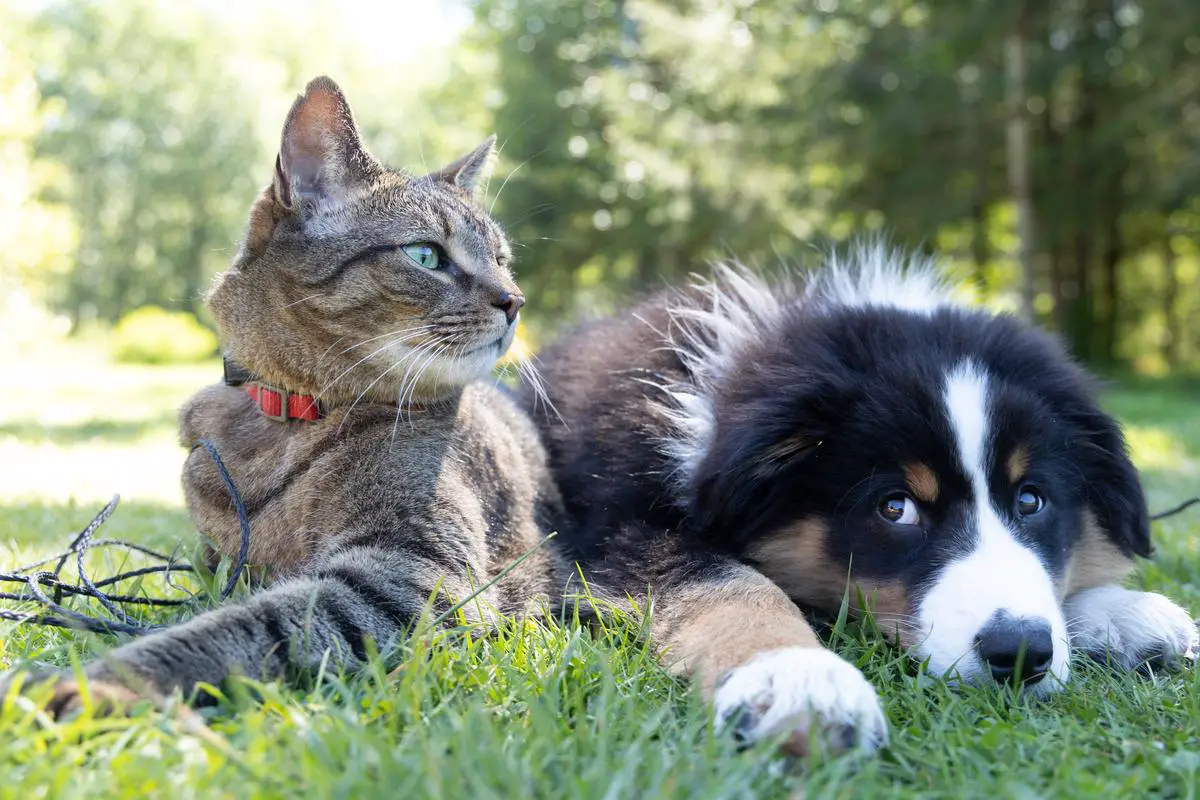Most of us view chocolate as a sweet treat to be savored, embodying comfort, pleasure, and even a hint of luxury. However, for our beloved animal companions, this indulgence can unleash harm, potentially life-threatening. Many pet owners are unaware of the dangers posed by chocolate consumption in animals until faced with a pet health crisis. Our animal friends, like dogs and cats, are susceptible to the effects of theobromine, a prevalent component in chocolate. Understanding how chocolate affects pets, recognizing the components that pose health dangers, and knowing which, if any, animals can safely consume this confectionery can greatly contribute to the maintenance of their health and wellbeing. Armed with this knowledge and preventive measures, pet owners can ensure their pets are steered clear from accidental ingestion and its subsequent detrimental consequences.
The Effects of Chocolate on Pets
Effects of Chocolate on Dogs and Cats
Chocolate contains substances known as methylxanthines, specifically caffeine and theobromine, which can be toxic to dogs and cats. For dogs, the theobromine in chocolate can lead to theobromine poisoning. It affects the heart, central nervous system, and kidneys. Symptoms can range from vomiting and diarrhea to panting, abnormal heart rhythm, and seizures. In severe cases, theobromine poisoning can even be fatal. Different types of chocolate have varying amounts of theobromine; it’s most concentrated in dark chocolates, cocoa powder, and baking chocolate.
Cats are also at risk but they generally lack the taste receptors for sweet foods and are less likely to eat chocolate on their own. If they do eat chocolate, they can experience symptoms similar to dogs. Cats may also exhibit symptoms of restlessness, increased heart rate, and excessive urination. It’s important to remember that individual reactions can vary widely in both cats and dogs, depending upon the pet’s size, overall health, and the amount and type of chocolate ingested. Therefore, to avoid any chocolate-related health risks, it’s best to ensure your pets don’t have access to it at all.
Immediate Actions for Chocolate Ingestion in Pets
Chocolate consumption can lead to a serious health crisis in pets and requires swift veterinary intervention. One of the first courses of action may be induced vomiting, only under veterinarian supervision, to evacuate the chocolate before complete absorption of a dangerous component called theobromine. Using activated charcoal could be recommended as well to prevent further absorption of this harmful substance. It’s crucial to understand there’s no specific antidote for theobromine poisoning. Accordingly, treatments are typically aimed at decontamination and supportive care, such as administration of intravenous fluids, medications to control heart rate, blood pressure, and seizure activity. Prevention, therefore, becomes the most effective safety measure. Always keep chocolate and other potential toxins away from pets.

The Theobromine Danger
Understanding the Hazard: Theobromine in Chocolate
Chocolate harbors a bitter alkaloid, theobromine, sourced from the cacao plant, which can pose a significant risk to certain animals. Differing from humans, animals metabolize theobromine slowly, leading to the build-up of toxic volumes in their system – a condition referred to as theobromine poisoning. The risk of theobromine poisoning from chocolate consumption can be influenced by several factors, such as the animal’s species, the quantity and type of chocolate consumed. Remember, the richer the chocolate, the higher the concentration of theobromine, and consequently, the higher the risk.
Understanding Theobromine Sensitivity in Animals
Different animals react to substances in unique ways, and this is particularly true when it comes to theobromine, a compound found in chocolate. While humans can consume chocolate mostly without issue, many animals can’t break down theobromine effectively, leading to the possibility of toxicity. Animals that are susceptible to theobromine poisoning generally include dogs, cats, birds, and rodents. Dogs are more prone because of their inclination to ingest anything they find tempting and their slow metabolism rate of theobromine. Similarly, smaller creatures, like birds and rodents, are also at risk, as even a small dosage can pose serious threats due to their low body weights. Some animals, such as pigs, metabolize theobromine quicker than humans do, lessening their risk. Nevertheless, it’s recommended not to feed them chocolate, and it’s wise to keep all chocolate and its byproducts out of pets’ reach.

Animals that Can Tolerate Chocolate
Can Any Animals Tolerate Chocolate? Exploring the Exceptions
While many animals are prone to chocolate poisoning due to theobromine, there still exist some surprising exceptions. Theobromine is a bitter alkaloid present in the cacao plant that acts as a stimulant on the central nervous system and cardiovascular system. Most animals are unable to metabolize this compound quickly enough to prevent harmful accumulation in their bodies, which can lead to serious health issues or even fatality.
Despite this, some conjectural pieces of evidence suggest certain animals might have a higher tolerance for chocolate. Primates such as gorillas and orangutans have been observed consuming small quantities of chocolate without any apparent immediate harm at zoos. This could be attributed to primate’s digestive systems sharing similarities with our own. However, these observations are largely anecdotal, and the long implications remain unclear. It is also worthy to mention, overconsumption of chocolate, even among humans, can cause health issues.
Birds, Rodents, and Their Tolerance for Chocolate
Though certain animals such as birds, rats, and mice have shown some tolerance to theobromine, a key ingredient in chocolate, this by no means signifies that it’s safe for them. The faster metabolism of birds seems to help minimize some of the harmful effects of chocolate, but only up to a point. It becomes dangerous, and possibly fatal, beyond this limit. Rats and mice, on the other hand, metabolize theobromine more effectively than dogs and cats. However, due to their small stature, even a tiny quantity of chocolate can potentially be harmful. For these reasons, it’s generally advised against feeding any variety of chocolate to animals, regardless of their demonstrated resistance to theobromine. It’s important to note that laboratory observations of animals consuming chocolate differ greatly from allowing pets to eat it at their leisure.

How to Prevent Chocolate Consumption in Animals
The Peril of Chocolate: A Widespread Threat to Animals
To fully grasp the severity of the situation, it’s essential to know that chocolate is unsafe for most animals, especially common household pets like dogs and cats. Chocolate contains theobromine, a substance highly toxic to these animals. It primarily affects the central nervous system and heart muscle, causing symptoms such as restlessness, hyperactivity, increased urination, and elevated heart rate. In extreme cases, ingestion of chocolate can result in seizures, heart failure, and even death in pets. Intriguingly, some animals, particularly dogs, have been observed to develop cravings for chocolate akin to humans, which highlights the need to store chocolate securely and out of their reach.
Keeping Your Pets Safe From Chocolate
For the sake and overall wellness of your beloved pets, taking measures to keep chocolates unreachable and unnoticed by them should be made a priority. This includes ensuring chocolates are stored in seal-tight containers, beyond pets’ range, and so also are wastebins which may contain used chocolate wrappers or containers. Trying to consume your treats out of your pets’ view can also be advantageous, as they may show curiosity and desire to try some. Situations may arise where it may not be immediately possible to seek your vet’s help if your pet ingests chocolate, in such cases, inducing vomiting under professional instructions can be a temporary solution. It is crucial to impart the knowledge about the toxicity of chocolates to pets among all the members of your household, especially kids.

Photo by tetiana_bykovets on Unsplash
What to Do If Your Animal Eats Chocolate
Understanding the Consequences of Chocolate Ingestion in Pets
Pets ingesting chocolates can show upsetting symptoms like an abnormal surge in their heart rate, over pacing, showing signs of unease, panting more than usual, experiencing muscle spasms, vomiting and diarrhea, and worst-case scenarios can include seizures or sudden collapse. Such symptoms generally show up between 6-12 hours of the pet consuming chocolate. Highly concentrated forms of chocolates such as dark chocolate, cocoa powder, and baking chocolate contain more of the toxic element, theobromine, hence even minimal amounts of these can be disastrous for pets. Even though milk chocolates contain less of theobromine, consuming large amounts can be harmful, more so for small-sized dogs and those with heart ailments.
Immediate Steps and Veterinary Assistance
If you suspect that your animal has ingested chocolate, it is crucial to seek immediate veterinary help. It can be helpful to note the quantity and type of chocolate the animal has consumed if known. This information can assist the vet in determining the potential severity of chocolate poisoning and guide appropriate treatment methods. Treatment may include inducing vomiting, administering activated charcoal to prevent further absorption of theobromine into the body, intravenous fluids, and medications to control any seizures or heart irregularities.
It’s important to know that no animal species effectively metabolize theobromine. Traditionally, dogs are the pets most commonly associated with eating and having reactions to chocolate, but cats and other animals can also be affected. However, cats are typically pickier eaters than dogs and less likely to eat chocolate. And while birds and rodents might be able to handle small amounts compared to their body size, they’re such small animals with rapid metabolisms that a toxic reaction can come about much more quickly. Keep all chocolate products out of reach of your pets to prevent accidental ingestion.

Undeniably, keeping our animal companions protected from the hazards of chocolate consumption is of paramount concern. Education on this topic equips us to recognize and prevent inadvertent ingestions and potentially secure their lives. By understanding the symptoms of chocolate poisoning and knowing what needs to be done in emergency situations, such knowledge becomes a powerful tool. It facilitates swift action that could very well mean the difference between life and death. By taking preventive measures, we work towards eliminating the risk altogether and ensuring the safety of our pets. It is our responsibility to guarantee our pets’ safety and wellbeing, and part of this entails acknowledging that chocolate – a harmless, delightful treat for us – harbors a hidden danger for them. Thus, chocolate, in no uncertain terms, should be kept out of their reach.





